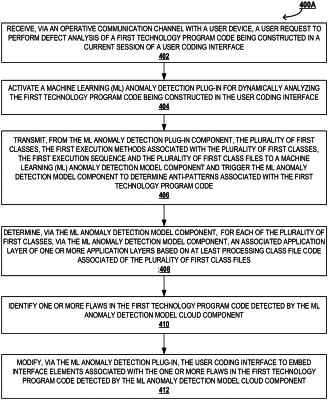| CPC G06F 11/3688 (2013.01) [G06F 11/3696 (2013.01); G06N 20/00 (2019.01)] | 20 Claims |

|
1. A system for machine learning-based anomaly detection in program code, wherein the system provides a machine learning (ML) anomaly detection model component structured to detect architectural flaws in the program code based on processing application logs associated with technology program code and determining flow sequences between a plurality of layers of code, the system comprising:
at least one memory device with computer-readable program code stored thereon;
at least one communication device;
at least one processing device operatively coupled to the at least one memory device and the at least one communication device, wherein executing the computer-readable code is configured to cause the at least one processing device to:
receive, via an operative communication channel with a user device, a user request to perform defect analysis of a first technology program code;
detect a plurality of first classes invoked in a plurality of first application session logs of the first technology program code based on analyzing the plurality of first application session logs;
construct a first execution sequence associated with the first technology program code based on (i) the plurality of first classes and (ii) first execution methods associated with the plurality of first classes;
extract a plurality of first class files associated with the plurality of first classes of the first technology program code from a first repository location;
construct a machine learning (ML) anomaly detection model that is structured to (i) construct a first application layer map based on mapping each of the plurality of first classes associated with the first technology program code to one or more application layers, (ii) determine a first architecture pattern associated with the first technology program code, and (iii) determine whether the first technology program code is associated with an anti-pattern;
transmit the plurality of class files to the ML anomaly detection model and trigger the ML anomaly detection model to process the plurality of class files;
determine, via the ML anomaly detection model, that the first technology program code is associated with the anti-pattern, wherein the anti-pattern is associated with a defect; and
transmit, via the ML anomaly detection model, an anti-pattern data file associated with the anti-pattern of the first technology program code.
|